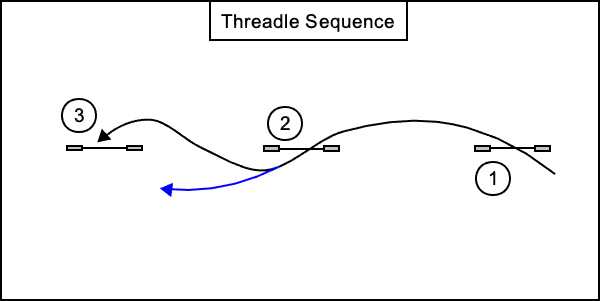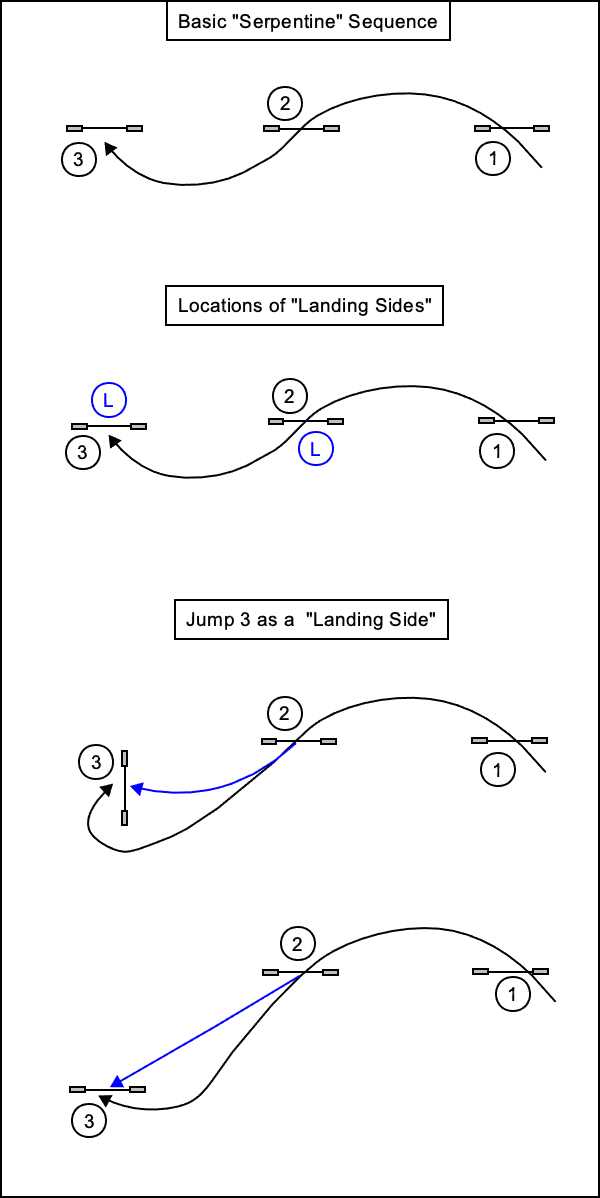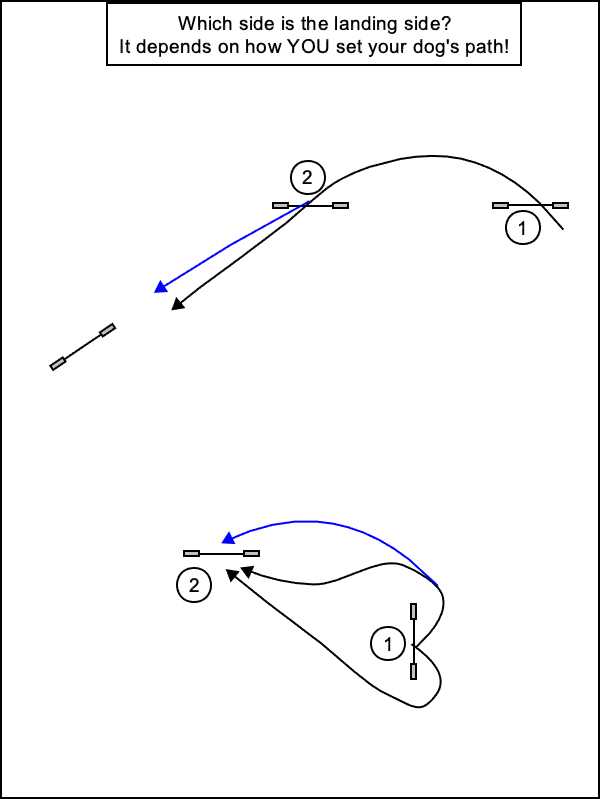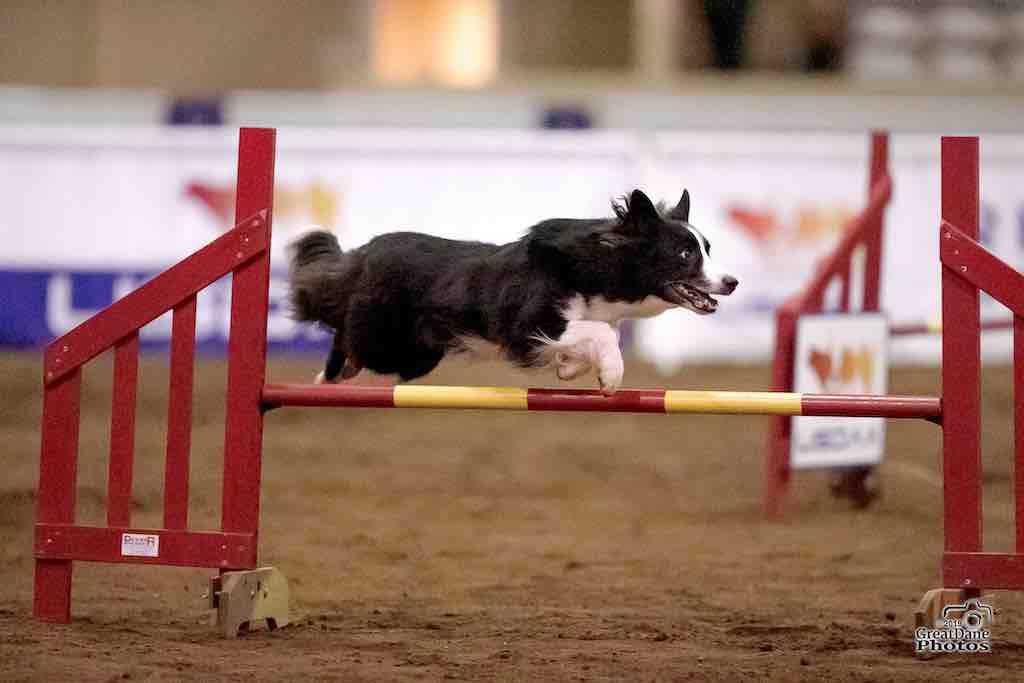Landing Side, Non-Obvious, Off-Flow Obstacle Approaches
01 Mar 2020
When dog agility was first introduced, the side of the next obstacle on the dog’s path was always the side of the obstacle the dog should take. As our sport evolved judges designed courses where the dog’s “obvious path” put them facing off-course obstacles or set the dog up facing the “wrong” side of the next obstacle.
The most common example is sending a dog to the Back Side Handling the Quad Back Side - Patrick Bucher Course/VideoThe Connection Between Threadles and Back SidesBack Side/Back Side JumpBack Side of Jump Handling Combinations - Video of a jump. The blue dog path shows the dog’s “obvious” path from jump 1 to the incorrect side of jump 2. The black dog paths show how the dog might be directed to the desired, non-obvious side of the jump.

Another common case is a Threadle Mary Ellen Barry on Threadle HandlingSingle Sided Threadle HandlingThe Connection Between Threadles and Back SidesTraditional Threadle HandlingThreadle Sequence as shown from jump 2 to jump 3:

Back Sides and Threadles can be grouped into a more common category of jumping sequence challenges commonly called “Landing Side Approaches”. I believe Linda Mecklenburg first introduced me to that term.
“Landing Side Approach” refers to the need for the handler to direct the dog to what would be the landing side of a jump instead of the side of the jump presented to the dog by their path through the previous obstacles. I’ve also used the terms “Non-obvious side” and my new favorite: “Off Flow side”.
The first image in the diagram below shows a Serpentine Serpentine Handling TechniquesSerpentine Sequence and how the dog’s path naturally puts them on the take-off side of the next obstacle. I’ve put blue “L”s in the second diagram to indicate the Landing Side of jumps 2 and 3. The final diagrams show how the rotation and location of an obstacle affect whether the desired side of the jump is a Landing Side Approach.

The key to whether the side of an obstacle is considered a Landing Side Approach or not is if the dog’s path through the previous obstacle(s) sets the dog up for the obvious side of the obstacle in question. Landing Side Approaches challenge the handler to Cue the dog to take the desired, non-obvious, side of the obstacle.
In the first sequence in the diagram below, you can see the judge has put the third jump in a location and rotation so the “obvious” side of the jump will be very dependent on how the dog is handled through jumps 1 and 2. For some dogs one side of the jump might be the Landing Side and for others it might be the other side.
In the second sequence, you can see how the handler’s choice of dog path through the obstacles can remove a Landing Side Approach. (I call the second diagram an “AKC Threadle” because, at one time, threadles weren’t allowed in AKC courses unless they could be handled as shown in the black dog path at the bottom.)

There is nothing about Landing Side Approaches that limits them to jumps. In the diagram below you can see the weaves and tunnel can be approached in the “obvious flow” as shown at obstacles 1 and 2 or as Landing Side Approaches as shown for obstacles 3 and 4.

Weave entry 3 and tunnel entry 4 are Landing Side Approaches because the handler has to move the dog past the obvious end of the weaves and tunnel entrance respectively.
Some people find it awkward to use the term “Landing Side Approach” for obstacles like tunnels and weaves where the dog doesn’t “land”. That’s why I’ve started liking the term “Off Flow” side/end instead.
Long story short, here’s my definition of a Landing Side Approach:
- Landing Side Approach
When the handler must direct the dog to the side or end of an obstacle that is not on the dog's obvious path.
or
When the handler must direct the dog to move past the obvious side/end of an obstacle to reach the desired side/end of that obstacle.
Other Resources
- Linda Mecklenburg covers training jumping skills for Back Sides, Threadles, and Serpentines in her Mastering Jumping Skills for Awesome Agility Dogs book.
- Daisy Peel has an online course called 'In' FOR THE WIN - ALL ABOUT LANDING SIDE APPROACHES.
Cover photo Flyer at 2019 Cynosport copyright Great Dane Photos and used with permission.
If you enjoyed this article won't you please:  Thanks!
Thanks!
